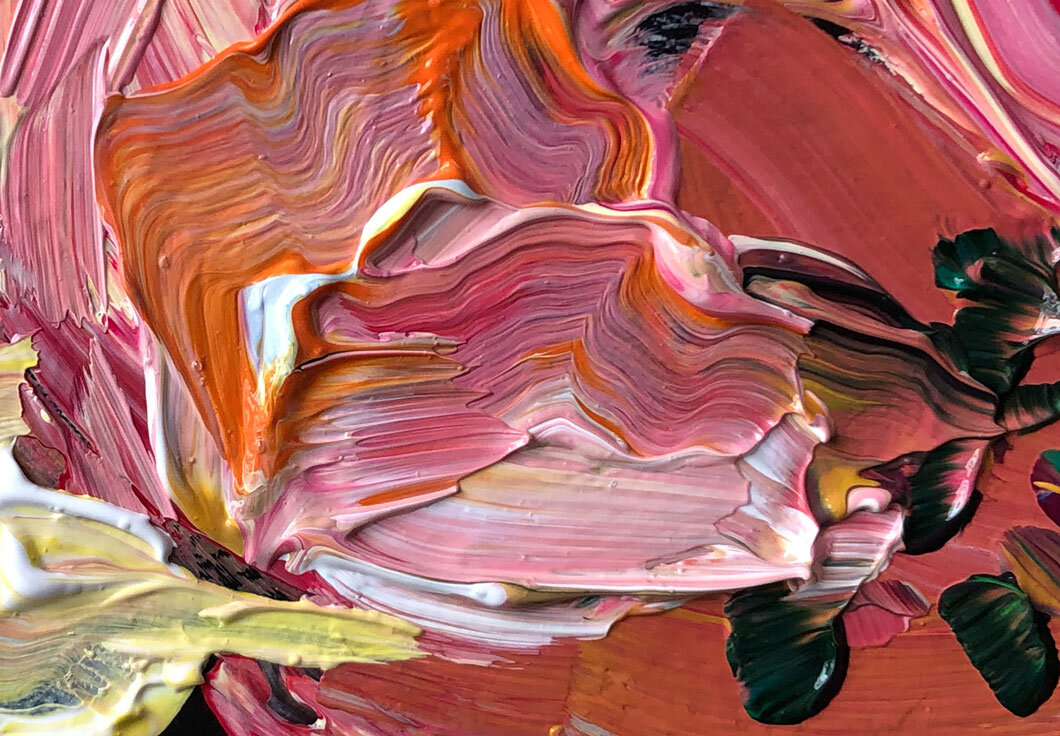Martwa natura z kwiatami Maria van Oosterwijck 1669 link do reprodukcji Cincinnati Art Museum,
05/60 Flora
Kup Pani kwiaty! - Ale to cięte...szkoda. - Pani, życia to szkoda! Holenderska martwa natura z kwiatami przywodzi mi na myśl zasłyszaną rozmowę na targowisku. Wszystko przemija. Nadzieja jak motyl, przysiadła niepewnie na skraju obrazu. Przepoczwarzający się z gąsienicy owad jest symbolem nowego życia - Chrystusa - w nurcie barokowego vanitas. To także znak firmowy malarki Marii van Oosterwijk. Jej klientami byli m.in Cosimo de 'Medici, Ludwik XIV i Jan III Sobieski. Ceny jej obrazów kilkukrotnie przewyższały prace Rembranta. Mimo uznania i sukcesu finansowego nie została przyjęta do gildii malarzy ze względu na płeć. Jej portret autorstwa Wallerant Vaillant można zobaczyć w kolekcji Rijksmuseum. Podobnie jak wiele innych obrazów z kwiatami autorstwa m.in. Rachel Ruysch - córki znanego anatoma, a zarazem prawdopodobnie uczennicy Oosterwijk. Co ciekawe jedna z prac Oosterwijk zachowała się z oryginalną ramą umożliwiającą zamocowanie kotary, która nie tylko chroniła przed słońcem i mechanicznymi uszkodzeniami, ale także dodawała tajemniczości umożliwiając prezentację obrazu tylko wybranym osobom.
Każdy kwiat, użyta barwa miały znaczenie czytelne dla ówczesnych odbiorców. Patrząc z dzisiejszej perspektywy widzę przede wszystkim barwną symfonię. Mimo upływu trzystu lat pełną świeżości - transformującej siły sztuki. W swojej interpretacji postanowiłam podjąć temat tworzenia na skraju realizmu i abstrakcji. Zagruntowałam mieszanką ultramaryny, zieleni i magenty tektury pod dwie alternatywne wersje. Nie przygotowałam tym razem szkicu ani koncepcji. Nakładając kolejne plamy patrzyłam jak rezonują ze sobą i na tej podstawie dodawałam kolejne. Gdy traciłam trop pracując nad jedną pracą zaczynałam drugą stojącą obok na sztaludze. Tak mimowolnie powstał dyptyk.
Rośliny nigdy nie były moim tematem wcześniej. Podjęłam go ze względu na wasze sugestie. Sama jestem zaskoczona jak bardzo interesująca okazała się ta malarska wyprawa. Co Wy sądzicie o tej tematyce? Jakie w Was budzi wrażenia holenderska martwa natura z kwiatami? Jak namalowalibyście ten temat dzisiaj? Zamieście prace i komentarze poniżej lub pod tym linkiem na Facebooku!
pod tym linkiem więcej wypraw dookoła malarstwa #60obrazow / kultura w sieci






Flora Daria Rzepiela, 2020 akryl na tekturze,
Flora
Buy the flowers Mrs! - Cut flower will be gone soon...- Life’ll be gone soon Mrs! Dutch still life with flowers reminds me of an overheard conversation in a marketplace. Everything passes. Hope like a butterfly, perched uncertainly on the edge of the painting. The insect lurking from the caterpillar is a symbol of a new life - Christ - in the baroque vanitas trend. It is also a trademark of the painter Maria van Oosterwijk. Her clients included Cosimo de 'Medici, Ludwik XIV and Jan III Sobieski. The prices of her paintings were several times higher than those of Rembrant. Despite recognition and financial success, she was not admitted to the painters' guild due to the gender. Her portrait by Wallerant Vaillant can be seen in the Rijksmuseum collection. Like many other paintings with flowers by Rachel Ruysch - the daughter of a well-known anatoma, and probably an Oosterwijk’s student. Interestingly, one of the works of Oosterwijk has been preserved with the original frame enabling the attachment of the curtain, which not only protected from the sun and mechanical damage, but also added mystery enabling the presentation of the image only to selected people.
Each flower, color used had a meaning readable for artist’s contemporary recipients. Looking from today's perspective, I see above all a colorful symphony. Despite the passage of three hundred years still full of freshness - the transforming power of art. In my interpretation, I decided to take up the topic of creation on the verge of realism and abstraction. I primed with a mixture of ultramarine, green and magenta cardboard for two alternative versions. I did not prepare a sketch or concept this time. Applying subsequent spots, I watched them resonate with each other and on this basis I added more. When I lost track while working on one painting, I started the other standing next to the easel. This is how a diptych was involuntarily created.
Plants have never been my topic before. I took it because of your suggestions. I am surprised myself how interesting this painting expedition turned out to be. What do you think about this topic? What are your impressions of Dutch still life with flowers? How would you paint this topic today? Please post Your works and comments on Facebook using this link!
click here to see more painting expedition #60paintings / kultura w sieci

